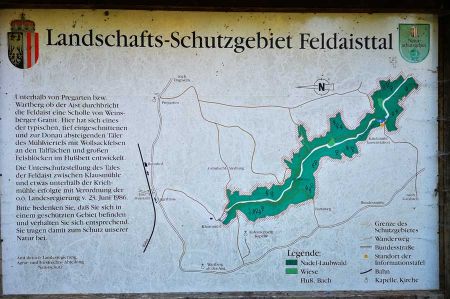Hiking trail along the idyllic Feldaist River in Austria
- Written by Portal Editor
At the beginning of our hike into the picturesque Feldaist valley, which we have planned for today, the Bruckmühle in Pregarten is our chosen starting point and is now home to active cultural and artistic workers as well as the region’s associations.
It is the cultural center of the Pregarten-Hagenberg-Wartberg region and the surrounding communities. The Bruckmühle is thus a cultural production site where encounters, education, art and theater are particularly important.
The Feldaist river rises in Oberrauchenödt
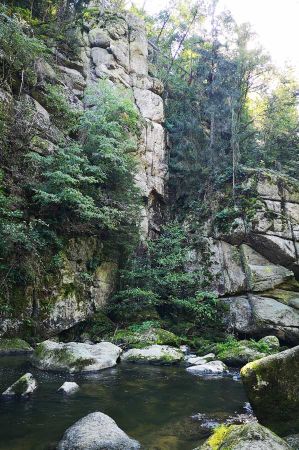 From the public parking lot of the Bruckmühle, we first hiked down a narrow road to the banks of the Feldaist river, then we follow the wildly romantic footpath, which is lined with steep rock faces and rushing water and leads through the idyllic Feldaist valley.
From the public parking lot of the Bruckmühle, we first hiked down a narrow road to the banks of the Feldaist river, then we follow the wildly romantic footpath, which is lined with steep rock faces and rushing water and leads through the idyllic Feldaist valley.
At this point, we noticed a warning sign in the garden of a resident: The dog is trustworthy and kind, even when it barks. But there is a warning against the property owner!
In general, the Felsaist is a river that is just 52 kilometers long and has its source near the church of St. Michael in Oberrauchenödt (in the municipality of Grünbach) at an altitude of 880 meters. The Feldaist flows in a north-westerly curve to Rainbach. In contrast to the Waldaist located to the east and only slightly longer, the Feldaist located to the west has no source rivers.
Felsensteiner Chapel, Klausmühle and Kriehmühle
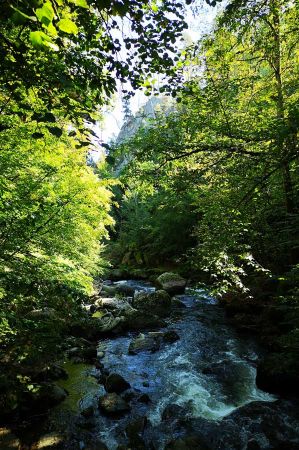 The following section of the valley to Freistadt is called Thurytal, then it continues in a southerly direction, pasts Kefermarkt and Pregarten, and joins the Waldaist to Aist at Hohensteg in the municipality of Schwertberg, which then finally flows into the Danube.
The following section of the valley to Freistadt is called Thurytal, then it continues in a southerly direction, pasts Kefermarkt and Pregarten, and joins the Waldaist to Aist at Hohensteg in the municipality of Schwertberg, which then finally flows into the Danube.
We are quickly in the original terrain, sometimes it goes up over gnarled root stocks of the dense forest, then again over stony passages down to the river. We first passed the Klausmühle, then passed the former emergency mill (Notmühle), we crossed the river via the Jahnsteg and further downstream we followed the signs to Silberbach. The name Notmühle probably comes from the fact that it could still be ground in this mill even when the water level was low, because the system of this weir was particularly cheap and could still be operated even with residual water. The emergency mill had three grinders and even a phole saw.
Every now and then it got quiet, the Feldaist flows noticeably slower.
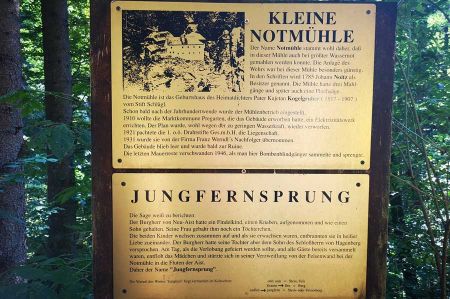 From Silberbach we hike over open, panoramic terrain towards Giemböcksiedlung and on towards Hohensteg. Shortly before Hohensteg, another footbridge leads over the Feldaist - a meadow path brings us to the beautiful Felsenstein chapel. We hike to Altenhaus and further into the wild and romantic Feldaist valley, which rightly bears the name "scenic pearl". Signs for the maiden jump bring us back to the banks of the Feldaist, where, according to mythology, a girl is said to have taken her own life because of an unfulfillable love.
From Silberbach we hike over open, panoramic terrain towards Giemböcksiedlung and on towards Hohensteg. Shortly before Hohensteg, another footbridge leads over the Feldaist - a meadow path brings us to the beautiful Felsenstein chapel. We hike to Altenhaus and further into the wild and romantic Feldaist valley, which rightly bears the name "scenic pearl". Signs for the maiden jump bring us back to the banks of the Feldaist, where, according to mythology, a girl is said to have taken her own life because of an unfulfillable love.
Neuaist castle complex is older than the Altaist pendent
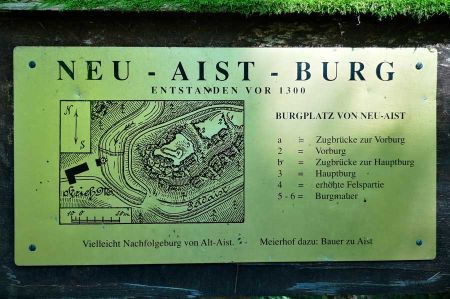 The sparse remains of a castle, Neuaist Castle, lie on a hilltop surrounded by the Feldaist. The Burgstall, originally secured by two section trenches, is located on the left bank of the Feldaist, opposite the Kriehmühle in the Pregarten community. Probing by Alfred Höllhuber has brought about ceramic finds from the 11th century (time horizon approx. 1000–1250 with a focus on the 2nd half of the 12th century); therefore it is reasonable to assume that Neuaist is older than Altaist Castle. Neolithic finds also came to light on the castle rock and on the slope. On the boulders in the river there are cavities for a wooden bridge. However, the important complex is not a listed building, probably due to the rather sparse remains.
The sparse remains of a castle, Neuaist Castle, lie on a hilltop surrounded by the Feldaist. The Burgstall, originally secured by two section trenches, is located on the left bank of the Feldaist, opposite the Kriehmühle in the Pregarten community. Probing by Alfred Höllhuber has brought about ceramic finds from the 11th century (time horizon approx. 1000–1250 with a focus on the 2nd half of the 12th century); therefore it is reasonable to assume that Neuaist is older than Altaist Castle. Neolithic finds also came to light on the castle rock and on the slope. On the boulders in the river there are cavities for a wooden bridge. However, the important complex is not a listed building, probably due to the rather sparse remains.
We have arrived at the end of the Feldaist valley and are happy to have got to know this place. A dreamlike backdrop accompanied us for many kilometers and offered a wonderful spectacle of light. The reflections of the bank forest on the water alone are worth the walk.
Please read as well:
A tour to the Mühlviertel and hiking along Feldaist
Hiking - The stone arch bridges in Pindos Mountains
 Hiking along Feldaist river in Pregarten / Austria
Hiking along Feldaist river in Pregarten / Austria
Hiking along Feldaist river in Pregarten / Austria
Hiking along Feldaist river in Pregarten / Austria
 Hiking along Feldaist river in Pregarten / Austria
Hiking along Feldaist river in Pregarten / Austria
Hiking along Feldaist river in Pregarten / Austria
Hiking along Feldaist river in Pregarten / Austria
 Hiking along Feldaist river in Pregarten / Austria
Hiking along Feldaist river in Pregarten / Austria
Hiking along Feldaist river in Pregarten / Austria
Hiking along Feldaist river in Pregarten / Austria
 Hiking along Feldaist river in Pregarten / Austria
Hiking along Feldaist river in Pregarten / Austria
Hiking along Feldaist river in Pregarten / Austria
Hiking along Feldaist river in Pregarten / Austria
 Hiking along Feldaist river in Pregarten / Austria
Hiking along Feldaist river in Pregarten / Austria
Hiking along Feldaist river in Pregarten / Austria
Hiking along Feldaist river in Pregarten / Austria
 Hiking along Feldaist river in Pregarten / Austria
Hiking along Feldaist river in Pregarten / Austria
Hiking along Feldaist river in Pregarten / Austria
Hiking along Feldaist river in Pregarten / Austria
 Hiking along Feldaist river in Pregarten / Austria
Hiking along Feldaist river in Pregarten / Austria
Hiking along Feldaist river in Pregarten / Austria
Hiking along Feldaist river in Pregarten / Austria
 Hiking along Feldaist river in Pregarten / Austria
Hiking along Feldaist river in Pregarten / Austria
Hiking along Feldaist river in Pregarten / Austria
Hiking along Feldaist river in Pregarten / Austria
 Hiking along Feldaist river in Pregarten / Austria
Hiking along Feldaist river in Pregarten / Austria
Hiking along Feldaist river in Pregarten / Austria
Hiking along Feldaist river in Pregarten / Austria
 Hiking along Feldaist river in Pregarten / Austria
Hiking along Feldaist river in Pregarten / Austria
Hiking along Feldaist river in Pregarten / Austria
Hiking along Feldaist river in Pregarten / Austria
 Hiking along Feldaist river in Pregarten / Austria
Hiking along Feldaist river in Pregarten / Austria
Hiking along Feldaist river in Pregarten / Austria
Hiking along Feldaist river in Pregarten / Austria
 Hiking along Feldaist river in Pregarten / Austria
Hiking along Feldaist river in Pregarten / Austria
Hiking along Feldaist river in Pregarten / Austria
Hiking along Feldaist river in Pregarten / Austria
 Hiking along Feldaist river in Pregarten / Austria
Hiking along Feldaist river in Pregarten / Austria
Hiking along Feldaist river in Pregarten / Austria
Hiking along Feldaist river in Pregarten / Austria
 Hiking along Feldaist river in Pregarten / Austria
Hiking along Feldaist river in Pregarten / Austria
Hiking along Feldaist river in Pregarten / Austria
Hiking along Feldaist river in Pregarten / Austria
 Hiking along Feldaist river in Pregarten / Austria
Hiking along Feldaist river in Pregarten / Austria
Hiking along Feldaist river in Pregarten / Austria
Hiking along Feldaist river in Pregarten / Austria
 Hiking along Feldaist river in Pregarten / Austria
Hiking along Feldaist river in Pregarten / Austria
Hiking along Feldaist river in Pregarten / Austria
Hiking along Feldaist river in Pregarten / Austria
 Hiking along Feldaist river in Pregarten / Austria
Hiking along Feldaist river in Pregarten / Austria
Hiking along Feldaist river in Pregarten / Austria
Hiking along Feldaist river in Pregarten / Austria
 Hiking along Feldaist river in Pregarten / Austria
Hiking along Feldaist river in Pregarten / Austria
Hiking along Feldaist river in Pregarten / Austria
Hiking along Feldaist river in Pregarten / Austria
 Hiking along Feldaist river in Pregarten / Austria
Hiking along Feldaist river in Pregarten / Austria
Hiking along Feldaist river in Pregarten / Austria
Hiking along Feldaist river in Pregarten / Austria
 Hiking along Feldaist river in Pregarten / Austria
Hiking along Feldaist river in Pregarten / Austria
Hiking along Feldaist river in Pregarten / Austria
Hiking along Feldaist river in Pregarten / Austria
 Hiking along Feldaist river in Pregarten / Austria
Hiking along Feldaist river in Pregarten / Austria
Hiking along Feldaist river in Pregarten / Austria
Hiking along Feldaist river in Pregarten / Austria
https://www.alaturka.info/en/general/373-fahrrad-und-wandertouren/5452-hiking-trail-along-the-idyllic-feldaist-river-in-austria#sigProId28a1718a2e
